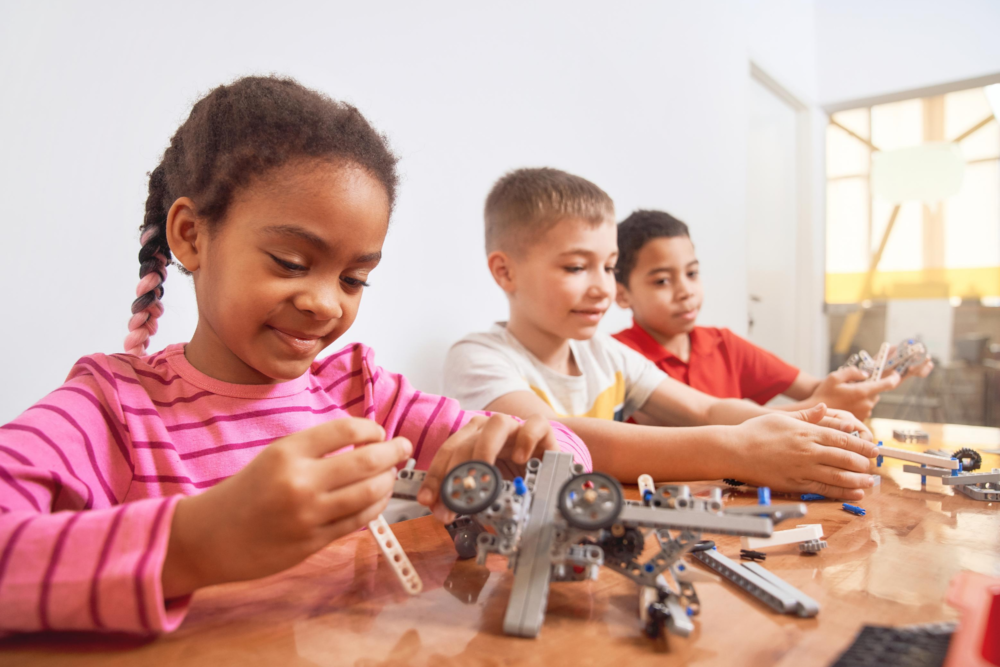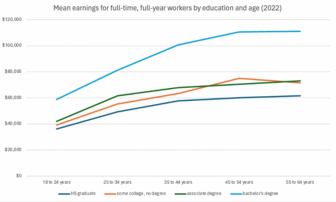After a number of years, I’m preparing to step away from my work at Michigan Future at the end of this month. I am offering a series of reflections on education in Michigan from my years of work understanding what the future, and the present, will demand of our children. While there have been many others, my most critical learning opportunities have been: our relationships with the school leaders that were a part of Michigan Future Schools; planning, with a series of remarkable educators, the Outsmarting the Robots event, where we tried to model the learning experiences we should be offering to kids; and each of the leaders, educators, and researchers I interviewed during the pandemic for What Now?–our video series on education.
This first reflection entry is my attempt to work upwards from what I want from school for my kids, to what the school has to be to provide that, to how the education system should be shaped to foster those types of schools. What I must say at the outset here is that what I want for my own kids, I want for all of Michigan’s children. I believe our system is providing this type of education in pockets, but is not currently designed to provide what I want for all, and our primary challenge in resolving this is one of system design. While I support more equitable school funding, I don’t think more money is enough.
What do I want from the school I send my children to?
- To prioritize at all times their social-emotional well-being; to observe them fully as humans; to address them and their learning as individuals and to find ways, within reason, to let their particular learning style come to work in the classroom.
- To have a vision for the type of skills that my kids need, and how to build those skills over time, knowing that skill-building is not something that happens in one year.
- To actively welcome and affirm my children’s identities. (This is somewhat automatic in our current system for my white, middle class, non-disabled girls. But needs to be true for students of color, indigenous students, immigrant students, poor, neurodivergent, LGBTQ+, and/or trans kids.)
- To make my kids feel that they have the ability to ask interesting questions and pursue the answers.
- To allow my kids to explore some of their own interests in the classroom and as the vehicle for learning. Not all the time, necessarily, but sometimes. (Frankly I also want them to learn that once in a while, they also have to just put their head down and do something not fun because it’s a part of making the day work for everyone else.)
- To help my kids develop a feeling of responsibility to their community, and a sense of their own power to be a positive contributor to their community.
- To provide a sense that my kids have the power to learn anything they put their minds to, and that they belong and are valued, and their particular contributions appreciated in their school community.
- To help my children see their peers as valued co-learners and develop a sense that kids can learn from each other as well. Authority figures are not the only teachers, and in fact, sometimes authority figures are wrong. They need practice understanding their own perspective and how others might have different, also valuable perspectives.
- To spend the majority of time on things that are engaging and educational, a little bit of time on things that are just about relationships and fun, possibly a little time on things that aren’t engaging but we just have to do, and just enough assessment to make sure the teacher understands where they are.
- To expose my children to a wide range of disciplines and modes of thinking, including creative expression through visual arts, music, etc. and meaningful scientific and sociological exploration, to a sufficient degree that they can figure out where their own interests lie.
- To encourage them to think critically about why the world is the way it is.
What are the priorities of and attributes of the school that will build what I care about?
- Because students do as teachers model, this is critical: teachers are learners. They are respected as creative, resourceful, and adaptive professionals. They model adaptive learning for their students. Their day and the structure of the school calendar gives them time to learn and design. They are invited to bring aspects of their own interests and enthusiasms into the classroom. Teachers are interested in why the world is the way it is.
- Teachers are skilled in recognizing the attributes, curiosities, and learning styles of their kids, to see them as individuals—even though they need to make some decisions to efficiently move the entire class along.
- Teachers are skilled in assessing students from observation and review of work. Teacher feedback for students and parents is in-depth and based in these observations and the opportunities for growth that matter most to the individual child.
- Teachers have freedom to alter how they facilitate their classroom to best engage the individual students in the classroom, while balancing that engagement against adequate progress on some of the basic skills and sets of knowledge that kids need.
- At least some of the learning is project-based, allowing kids to build deep expertise—expertise that outpaces the teacher’s—in areas of interest, and building the skills that come with having to focus on a specific topic for an extended period of time (the definition of “extended” varies for different grade levels).
- Timelines for learning are flexible and generous. I am not so concerned about the how quickly or at exactly what age in elementary school my kids become readers or learn about the three branches of government. I would sacrifice speed of skill-development or content acquisition any day for depth of understanding and for keeping at bay any resentment/feelings of, “I’m not good at this; I’ll never get this.” Slow learning is OK.
- The flow of the day and the classroom is designed around how kids’ brains and bodies need to work, including movement, play, rest, and creativity. This is as true for high schoolers as kindergarteners.
- Work is interdisciplinary. Teachers knit together the subjects we think of as siloed to reflect the real world and how brains best make meaning of learning.
- There are opportunities—not necessarily on every day or in every subject—to somehow engage authentically with the world outside the classroom, whether by interviewing experts, undertaking a community service project, or advocating for new speed bumps by the school.
- The school as a whole has a unified vision or philosophy about how learning happens there and how to support and empower teachers and students in a way that builds community, builds on strengths, and creates room for individuals.
What are the attributes of a system that fosters these types of schools?
- It articulates the goals as the development of critical skills or human capacities.
- The system incentivizes leaders who want to undertake a district transformation, and rewards districts whose schools have developed a unified strategic approach that includes skill development.
- The system articulates a streamlined set of content knowledge and/or standards that is required across the system, but provides flexibility about when those sets of knowledge must be the centerpiece of learning.
- It funds schools adequately to fund quality teachers and makes investments in ongoing learning and collaboration.
- It pays teachers a family-supporting wage that increases with expertise.
- It creates objective, research-based rubrics for districts who are embracing skills-based approaches to allow them to share meaningfully across districts and to provide evidence for what’s working, or not working.
- It takes advantage of some economies of scale to subsidize the expense of curricular pivots.
- The system overall assesses and shares what schools are doing and how well these strategies are working to contribute to the overall body of knowledge of how learning happens. (Through qualitative as well as quantitative measurement.)
- The system avoids adding requirements that are not essential to meeting the goals.
- It adds a layer of statewide “double checking” to ensure students and schools aren’t slipping through the cracks, with an emphasis on hidden inequities in opportunity.
- It helps align the teacher development system around the facilitation, observation, and lesson design skills that are described in the previous section.
- It provides support for the districts to care for student needs outside of the classroom, especially in higher-need districts or for higher-need kids.








